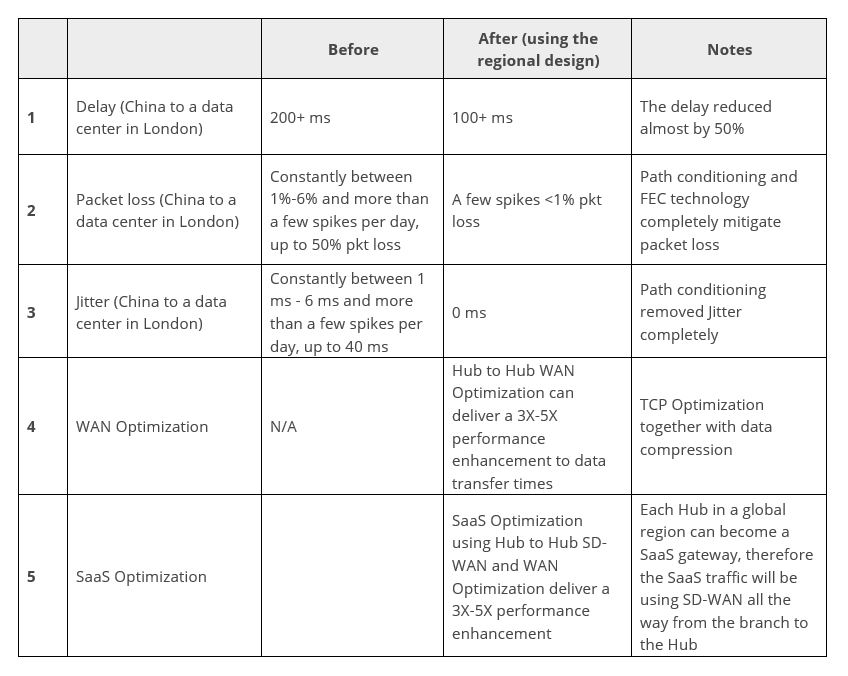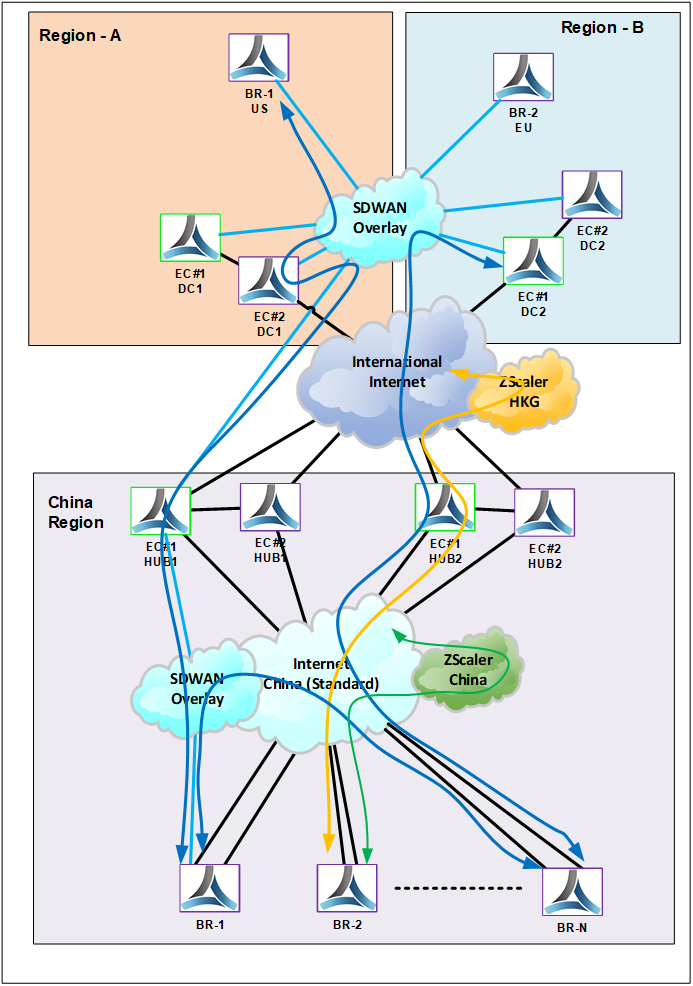SD-WAN Regional Design with SASE Architecture
Many enterprises that have branches in remote and poorly connected regions, such as China, experience significant connectivity and performance issues when accessing services and data hosted outside of those locations. For example, from a bandwidth and security perspective, China’s local internet heavily restricts communication outside of the country, causing severe problems with secure connectivity to applications in data centers or cloud locations in other regions.
Implementing a modern SASE (Secure Access Service Edge) architecture from these branches requires the traffic to go via Cloud Security Providers (CSPs), such as Zscaler or Palo Alto Networks Prisma. However, these services do not adequately address performance problems. That’s because branch users send the traffic via the CSP node in China, resulting in the same performance and connectivity issues after the CSP puts the traffic back on the internet.
These same connectivity issues also affect SaaS. SD-WAN vendors cannot ‘spin up’ virtual machines (VMs) in SaaS clouds, and some SaaS solutions are only in a single cloud or a few locations. They also have other restrictive requirements, such as a maximum of 150 milliseconds Round Trip Time (RTT). Bearing in mind that RTT from China/Africa/Australia to Europe alone is well over 200 milliseconds, how could an office in China, or South Africa, for example, connect to SaaS applications based in Europe or the United States?
Although several solutions can address connectivity issues, the performance issues will remain. These connectivity solution options include:
1 – MPLS (Multiprotocol Label Switching) Provider
An MPLS provider will guarantee connectivity. However, the downside is low performance and bandwidth, slow deployment and, as MPLS is needed at each branch, this solution is also expensive to implement.
2 – Microsoft Azure vWAN
While Microsoft Azure vWAN guarantees connectivity and is fast to deploy, similar to MPLS, performance is low and bandwidth is low to moderate. It also requires manual IPSec (Internet Protocol Security) tunnels from each branch, which is expensive to deploy.
3 – Cloud-Based SD-WAN
Cloud-based SD-WAN benefits from fast deployment, guaranteed connectivity and performance improvements. However, this option can also be expensive to deploy, and bandwidth can be moderate.
A Better Way Forward with Teneo
At Teneo, we’ve created an alternative service based on an Aruba/Silver Peak Regional Design with a SASE architecture. With this solution, each region has several hubs, which can incorporate specific sites or data centers with communication between the areas implemented via the hubs. Each region will also provide separate treatment of business applications, which in Aruba/Silver Peak EdgeConnect terms means the Business Intent Overlays (BIOs) and the IPSec SD-WAN topology are region-specific.
Internet browsing can be done via the CSP. For example, with Zscaler, each branch’s EdgeConnect in China builds an IPSec tunnel, which is automatically configured via the Aruba Unity Orchestrator API, to the closest ZEN node(s) (Zscaler Enforcement Nodes) in China for local internet sites only. See the green path from BR-2 on the below diagram.
Each branch’s EdgeConnect in China has ‘SD-WAN connectivity’ via the hubs to the closest International ZEN nodes (such as Hong Kong or Singapore) for secure browsing of all international internet sites. See the yellow path from BR-2 on the below diagram.
This ‘split’ is a design based on Aruba’s Business Intent Overlay (BIO) technology and delivers a SASE (Secure Access Service Edge) architecture to improve security, connectivity, and performance.
China branch connectivity to corporate data centers, and applications (outside of China) are delivered via the hubs utilizing the SD-WAN Fabric and supporting all SD-WAN features. This includes FEC (Forward Error Correction) for packet loss mitigation; performance-aware routing based on link bonding policies; redundancy; and WAN Optimization (Data Duplication and Application Acceleration). The blue path in the diagram below represents China branch connectivity to the data center or another branch (in or outside the China region).
This solution brings numerous connectivity and performance improvements, including enhancements to security, connectivity and network, SaaS and remote user connectivity optimization, and cloud cost reduction.
Testing based on 30 days of live traffic monitoring by Teneo on an enterprise network with 18 sites in China, connecting to services in London, UK, produced the following results:
SD-WAN Regional Design and Traffic Paths
Could such a regional SD-WAN design with a SASE architecture help you to overcome connectivity, performance and security issues in regions like China, too?
For information about Teneo’s SASE and SD-WAN services, visit our services page, or use this meeting link to arrange a suitable time to talk.
Author: Roumen Doukov, Lead Global Solutions Architect, Teneo




